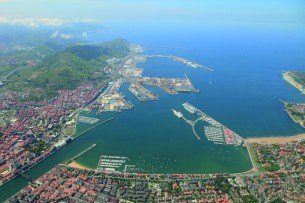Exports increased by 8% and the biggest increases
were with Central America, Asia-Pacific and Pacific South America
During the first half of the year nearly 15 million tonnes were handled by the Port of Bilbao facilities, which is an increase of 1.6% with respect to the same period last year (+233,131 tonnes).
By segment, dry cargo –including container traffic, conventional general cargo and dry bulk– rose nearly 3%. Particularly prominent were conventional general cargo (+ 5%) and container cargo (+ 4%), both with significant added value because, apart from indicating the port’s level of trade, call for a higher level of port labour and invigorate all the freight transport sectors. The number of containers handled, measured internationally in TEUs (Twenty Equivalent Unit, an international unit that is the equivalent of a 20-foot container), was 302,916, 2% up on June last year. Likewise, there was a 19% increase in reefer container exports, in other words, those that carry perishable goods.
Another positive sign is the change in the trend accumulated by both solid and liquid dry bulk, which following months of decline are now seeing increases.
As regards the goods transported, crude oil, which accounts for 24% of the traffic, remains the one with the highest volume, followed by steel products and fuel oil, each accounting for 10% of the total. The greatest increases in absolute terms were in diesel oil traffic, cement and clinker, steel products, food products, biofuels and metallurgical products.
Exports up
Exports made through the Port of Bilbao continue to grow, and until June had increased by 8%, while imports remain at similar levels to those of the first half of last year.
44% of external traffic takes place with countries in Atlantic Europe, although the greatest increases were with Central America (+ 39%), Asia-Pacific (+ 30%) and Pacific South America (+ 49%). At the same time, Bilbao continues to be the main port in Spain in terms of traffic with the United Kingdom, its main market.
More tourists
The total number of passengers using the Port of Bilbao facilities saw a 32% increase to 61,841 tourists. This considerable increase is due to the significant drive of cruise liner activity. 24 cruise liners called in, twelve more than until June of last year,
and there were 30,767 cruise passengers, 21,143 more than this time last year.
The Bilbao-Portsmouth ferry, however, carried only 31,074 passengers (-16%). This fall is due to the loss of two calls owing to the February storms.

More investment
In the first six months of the year turnover remained at 30.5 million euros, despite the storms in January and February, and the cut in port and pilotage dues being applied by the Port Authority of Bilbao since 1 January 2014, which have been offset by the increase in freight traffic.
The investment figure in the first six months was 20 million euros. Throughout 2014 the Port Authority will be investing a total of 54.7 million.
The main investments have been concentrated in the third cruise liner berth (completed in May), the extending of the Punta Sollana dock and the TELOF railway connection of Pancorbo. These three infrastructures are designed to capture more traffic which right now is opting for other port locations and, by extension, achieve greater wealth for our economy.
The Punta Sollana and Pancorbo works are being cofunded by the European Union. The Punta Sollana extension is part of the “Efficient Operations and Improvement in Environmental Performance” project, TEN-T 2012 call, and those of Pancorbo belong to the “IBUK-Intermodal Corridor” project, TEN-T 2011 call.

 Port access
Port access